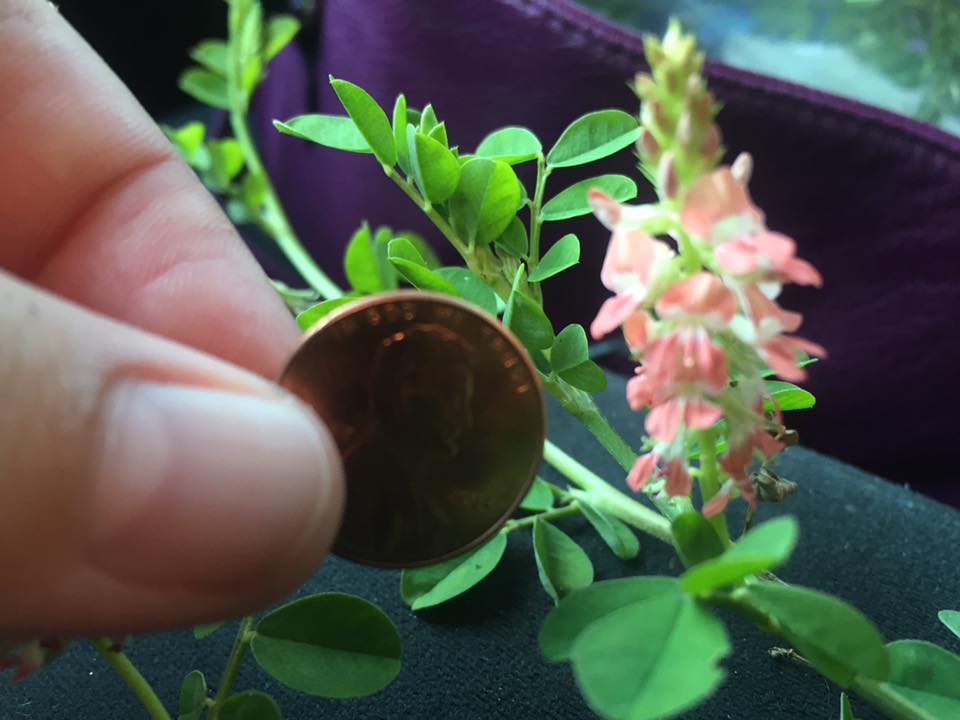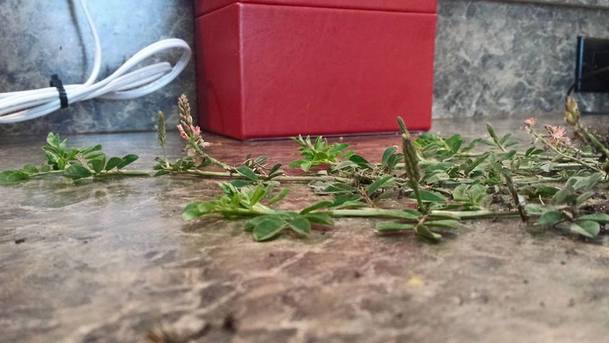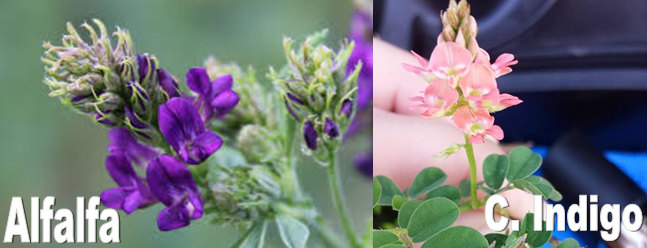The Flower :
Creeping Indigo's cone-shaped flower, when fully bloomed, looks like a miniature Snapdragon. (measuring no larger than 1in from base of bud to tip) The flower is often, the only part of the plant that grows vertically. Though, Creeping Indigo vines CAN actually grow up to 3in tall depending on it's environment/competition. The flower color ranges from coral/pink, to red, according to studies. (Our members have only every seen it in it's coral-pink shades) When the blooms are closed due to stress or as dusk approaches, the color is more difficult to see. And, when the blooms are not present at all- the weed becomes almost invisible to the eye, as it hides just below the grass line. The flower does bloom YEAR ROUND but, each plant is on it's own, individual, life cycle. Meaning that: not every plant has blooms/seed pods present at all times.
We have found- it is much easier to spot this weed in the Fall-Winter months. This is because, thanks to it's deep tap root- it is able to remain green while grass and other weeds become dry and pale in color due to cold temperatures and drought. But, this is also when the weed is MOST DANGEROUS. (read more on that, below).
WHY IS CI MOST DANGEROUS IN FALL-WINTER?
Creeping Indigo has a very deep tap root. (up to 6ft deep) Because of this, it is able to stay green longer in Fall-Winter and therefore, remain desirable in flavor while the rest of the pasture has become dry and flavorless from drought/cold.
It is also a known fact that CI seeds at it's highest rate during the Fall-Winter season. (up to 200-300 pods EACH PLANT!) Though, it is not known yet which parts of the CI plant contain the highest concentration of toxins; rule of nature with noxious weeds is that they hold the majority of their toxins in their seed pods/fruit.
CI is also believed to increase in toxicity when stressed. Stressors can include: drought, cold, mowers, herbicide treatment, high traffic etc.
In conclusion: Assuming that CI likely follows the rule of toxins being most concentrated in it's seed pods, combined with the fact that CI produces the highest number of seed pods during Fall-Winter, the liklihood that toxicity increases when stressed by cold/drought and knowing that the weed becomes even more desirable in comparison to the grass during this time...
The Fall-Winter season is considered to be the MOST DANGEROUS TIME for this weed.
The University of Florida has also made note, in their studies, that "outbreaks" in CI illness also coincide with this season. Which, further indicates that this hypothesis is correct.
We have found- it is much easier to spot this weed in the Fall-Winter months. This is because, thanks to it's deep tap root- it is able to remain green while grass and other weeds become dry and pale in color due to cold temperatures and drought. But, this is also when the weed is MOST DANGEROUS. (read more on that, below).
WHY IS CI MOST DANGEROUS IN FALL-WINTER?
Creeping Indigo has a very deep tap root. (up to 6ft deep) Because of this, it is able to stay green longer in Fall-Winter and therefore, remain desirable in flavor while the rest of the pasture has become dry and flavorless from drought/cold.
It is also a known fact that CI seeds at it's highest rate during the Fall-Winter season. (up to 200-300 pods EACH PLANT!) Though, it is not known yet which parts of the CI plant contain the highest concentration of toxins; rule of nature with noxious weeds is that they hold the majority of their toxins in their seed pods/fruit.
CI is also believed to increase in toxicity when stressed. Stressors can include: drought, cold, mowers, herbicide treatment, high traffic etc.
In conclusion: Assuming that CI likely follows the rule of toxins being most concentrated in it's seed pods, combined with the fact that CI produces the highest number of seed pods during Fall-Winter, the liklihood that toxicity increases when stressed by cold/drought and knowing that the weed becomes even more desirable in comparison to the grass during this time...
The Fall-Winter season is considered to be the MOST DANGEROUS TIME for this weed.
The University of Florida has also made note, in their studies, that "outbreaks" in CI illness also coincide with this season. Which, further indicates that this hypothesis is correct.





